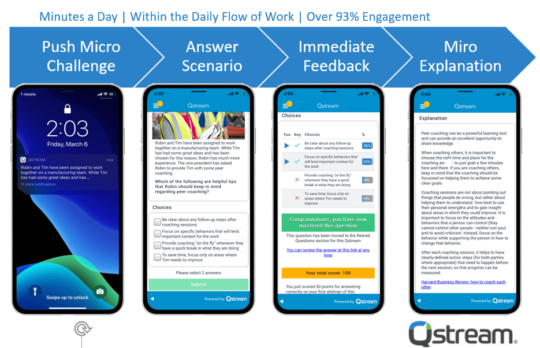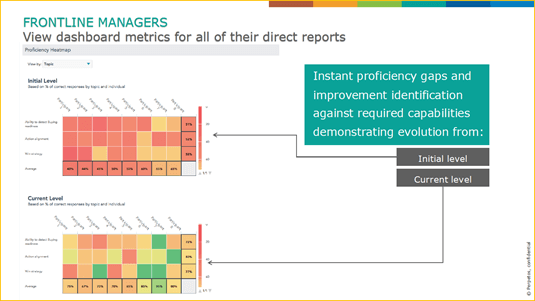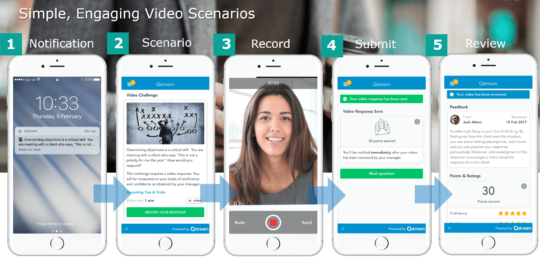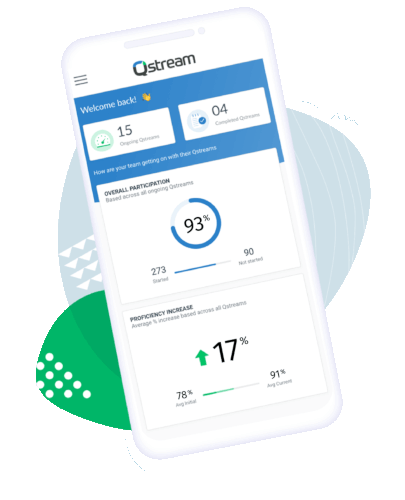In these times, professional salespeople are witnessing an unprecedented change in all aspects of the business world that will echo for years to come. Being an active part of this shift is crucial to the success of your business and the individuals that keep it running. What the sales function is confronted with is an unavoidable shift to remote learning in support of the demand to master the skills of remote selling.
In this blogpost, we discuss strategies to remotely train salespeople with new skills, refreshing their existing skill sets, and how to keep them motivated and engaged along the way in today’s hybrid selling world.
Sales teams face the need to immediately master remote selling
Today, selling has never been more difficult and requires salespeople to be very agile when selling virtually and connecting with their customers on a personal level. Now more than ever before, sales learning and development is extremely important for enabling salespeople to upskill and reskill to meet the new demands of your business and the needs of your customers all while selling from home. Normal methods of learning won’t cut it in these difficult times, a new training approach is required to help your salespeople go through their own digital transformation.
Turning in-person training and delivering via the web is not a solution
It is not just about turning your in-person training and delivering it through a video conference tool like Zoom or Teams. Nor is it effective to resort to traditional e-learning through a learning management system. Content that’s in your learning management systems is most likely not relevant to the new sales models that have been put into place because of all the changes businesses are making regarding the effects of COVID-19. Also, every moment an impatient sales professional spends sitting through time-consuming LMS courses is time away from selling. We must find better ways to reinforce topics throughout the normal workday without disrupting anyone’s workflow.
Step-by-step training
Many learning programs deliver so much information in short periods that it can be unreasonable to expect employees to pick everything up immediately. They are human, and humans have a natural tendency to forget. A more effective and lasting approach is to introduce new skills to employees while continually reinforcing what was previously taught to improve long-term knowledge retention. Once they show proficiency with a particular skill, you can move on to the next one. The key, however, is making sure that employees don’t forget what they initially learned. One way to ensure sales professionals retain what they learn is to embed micro-learning into your Learning & Development strategy.
Snackable and mobile learning to reinforce learnings
Research has proven that a great way to avoid disrupting sales people workflow is by pushing “bite-sized” chunks – no longer than 2 minutes per topic – so they can stay focused on their work and implement teachings into their day-to-day with ease. Mobile-first remote learning is essential in this effort. Even with more people at home, the “device of first attention” for most people is their mobile phone (Fig. 1).
Additionally, these reinforced training sessions can be done in pockets of free time rather than salespeople having to carve time out of their day to get it done. This way, everyone gets constant refreshers and reinforcement without any of the inconvenience.
Fig. 1: Bite-sized chunks of mobile learning through Qstream

Personalized learning paths that support corporate objectives
Your salespeople all come from different backgrounds and have different experiences, some may have already sold remotely before, so you need to take into consideration the different variations of knowledge sets by analyzing the knowledge gaps and using personalized learning that will meet the needs of each salesperson. Personalized learning paths can only be routed by understanding the proficiency and knowledge gaps of each individual.
We see 2 ways to personalize learning paths while supporting corporate objectives:
- Through popular microlearning applications like Qstream that allow to identify proficiency gaps and guide personalized development programs
- By means of qualitative and quantitative interviews, investigating common areas that affect sales performance. This deep dive into audiences’ learning needs will surface blockers and boosters of commercial performance and will allow to go directly into implementation mode with tailored content within a coherent corporate development program.
Interested in microlearning? Qstream is the only microlearning platform scientifically proven to increase knowledge, develop skills, and change behaviors.
Impact measurement and personalized coaching
Analytics from an LMS is historically insufficient for sales managers or trainers in determining if their salespeople are understanding what’s being taught. Microlearning platforms enable you to track and compare the evolution of sales engagement, proficiency and performance. The insights gained from these can help to leverage each individual’s strengths for the benefit of the other team members. Real-time dashboards and proficiency heat maps (Fig. 2) show initial and current proficiency, allowing you to assess progress and offer personalized coaching for each team member.
Fig. 2: Qstream dashboards with heat maps

Real-world scenarios
The key to keeping reps engaged is to feed them information that is relevant to what they are experiencing every day. Microlearning platforms like Qstream provide an easy method for learning by utilizing spaced repetition, cases and testing (Fig. 3). This way instant learning is obtained, and salespeople are able to incorporate the lessons into their daily routines and use that knowledge in real-time.
Fig. 3: Microlearning with roleplay on Qstream

Precise coaching
Mobile platform tools can paraphrase classroom content into 12-15 yes/no, multiple choice or scenario-based questions, helping your team to jog their memories and repeat what they have picked up during training. The system thus reinforces knowledge, not only by testing but continuous retraining at the same time.
Ambition, engagement and improving proficiency are encouraged through competition and gamification – with extra points for both speed and accuracy and real-time leaderboard. Managers receive suggested topics for coaching their team members as well as overview of how much progress individuals have made compared to earlier tests. Data-driven matrixes evaluate the impact of training, offering customized coaching opportunities for the team’s manager, based on individual and team results.
Making Sales training Stick
Competency does not come from periodic, one-time training. According to Ebbinghaus’ Forgetting Curve, learners forget 90% of what they learn from an event-based approach within 30 days, with most of the new material being forgotten within the first few hours after the training. A solution to promote knowledge retention is spaced learning.
Spaced learning implies multiple training opportunities. Repetition is indeed the mother of learning. We also notice great results by combining spaced learning with microlearning.
A systemic approach to learning
Key components of a systemic approach to learning for the mobile workforce will typically include a mix of learning strategies:
- Virtual training sessions that relate to the day-to-day operations and will equip salespeople with the confidence and capability to perform at their highest potential
- Experience-sharing sessions that will leverage peer-based support to unlock current difficult customer situations
- Individual coaching sessions to follow up on field implementation of newly acquired knowledge and skills
- Supplemental online training that will put the learner in contextually rich scenarios that are cognitively challenging.
- Spaced microlearning to break up complex or detailed job-specific learning content into scenarios and delivering this repetitively over time through a learning experience that fits into the daily flow of sales work
Combining these learning strategies will ensure that your upskilling becomes ingrained in individual habits, thereby making sales people better performers and more likely to have a positive impact on organizational goals.
Conclusion
The digital age requires an agile learning environment, supporting continuous learning. Hence the need to integrate spaced and mobile learning for continuous knowledge reinforcement and proficiency measurement. Creating the capacity to objectively measure the impact of improvement initiatives, and even measure proficiency, enables you to create individual learning paths on the one hand and encourage the implementation of effective sales strategies on the other.



 Eliseo Manfron
Eliseo Manfron